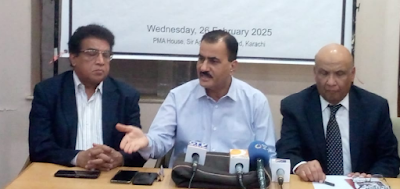Seminar stresses tougher tobacco controls amid alarming health crisis
 |
| ST File photo |
The
seminar, titled “Tobacco & Media: Shaping Perceptions and Driving
Policy,” was organised under the Voice Against Tobacco (VAT) initiative of
the Indus Hospital and Health Network (IHHN), Karachi. It brought together
civil society representatives, media practitioners, and senior health
professionals to discuss the growing influence of the tobacco industry on
Pakistani youth.
A central focus of the discussion was the unchecked availability of nicotine pouches, raising questions about regulatory oversight. Participants pointed out that if products like nicotine pouches — often prescribed by some doctors as cigarette alternatives — have medicinal value, then the Drug Regulatory Authority of Pakistan (Drap) should formally register and regulate them as medical products. They urged that novel nicotine products, including so-called tobacco-free pouches and e-cigarettes, be strictly banned for those under 18 at all points of sale.
Public
health consultant Dr Amina Khan, also CEO of The Initiative Pakistan, presented
findings from her recent survey conducted between December 2023 and May 2024.
The study involved 14,232 adolescents — 9,011 school-going and 5,221
out-of-school youth — across nine districts -- Peshawar, Dera Ismail Khan,
Rajanpur, Karachi, Badin, Quetta, Nasirabad, Rawalpindi and Islamabad.
Boys made up 64% of the surveyed population, while girls accounted for 36%, with the majority (55%) aged between 13 and 15.
Presenting
worrying figures, Dr Khan reported that 8.4% of adolescents, including 7.1% of
girls, had used some form of tobacco or nicotine product. Specifically, 1.6% of
the surveyed youth (including 0.7% of girls) reported cigarette use, 2.4%
(including 2% girls) used smokeless tobacco, 3.2% (including 2.7% girls)
accessed and used nicotine pouches, and 3.9% (including 3.2% girls) reported
using e-cigarettes.
The study also exposed the ease of access: 43.7% of respondents, including 32.3% of girls, said they could purchase tobacco and nicotine products within a five-minute walk from their homes. Peer influence was another major factor, with 16.2% reporting friends who smoked cigarettes, 15.5% having friends who used smokeless tobacco, 6.5% knowing friends who used e-cigarettes, and 5.8% having friends who consumed nicotine pouches.
Dr Khan
highlighted the particular rise in the use of emerging nicotine products among
girls, saying her research findings provide critical evidence for media
professionals and policymakers to tailor interventions accordingly. She
emphasised that these nicotine products are not risk-free and harm nearly every
organ in the body.
Other
speakers at the seminar emphasised the urgent need for policymakers, health
authorities, and communities to act decisively to protect young people from the
aggressive tactics of the tobacco industry. They identified opportunities for
evidence-based interventions and collaborative policymaking.
Opening the forum for discussion, Dr Saima Saeed, Director of Lung Health at IHHN, underscored the urgent need to address tobacco use in the country. “Tobacco continues to pose a significant threat to public health and socio-economic development, sparking collaborative, multi-sectoral action to mitigate its impact,” she said.
Syed
Safdar Raza from Aurat Foundation emphasised the need for tobacco control to be
treated as a national policy priority. “There are 24 million tobacco users in
Pakistan, with 160,000 deaths annually… This is definitely a national health
crisis resulting in cancer, heart diseases, strokes, and respiratory
illnesses,” he said, adding that about Rs615 billion are spent on healthcare
and productivity losses, compared to just Rs110 billion earned through tobacco
taxation.
He cited challenges such as weak enforcement, low taxation, and unrestricted youth access, and called for introducing comprehensive reforms, including increased taxation, enforcement of advertising bans, and expansion of public education and cessation services.
Dr Khalil
Ahmed of the Society for the Protection of the Rights of the Child
(SPARC) said there was a pressing need for counter-strategies, such as
comprehensive advertising bans and awareness initiatives at all levels, from
schools to communities, and from traders to media houses.
Journalist
Waqar Bhatti highlighted the critical role of the media in countering
misinformation and shaping public discourse. “We need to think afresh about the
changing shapes of tobacco products as well,” he said.
The forum,
largely attended by journalists, also expressed concern that the tobacco
industry often influences lawmakers and bureaucrats to serve its interests. The
participants emphasised that media professionals must prioritise health
reporting with factual and evidence-based content, which is achievable through
further capacity building in health journalism.
News report courtesy: Social Track, Karachi
Photos courtesy: IHHN








Comments
Post a Comment